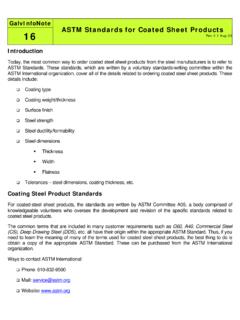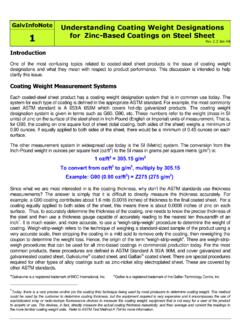Transcription of GalvInfoNote Galvannealed Coatings 5 How do …
1 GalvInfoNote Galvannealed Coatings 5 How do They Differ from Galvanized? Introduction The objective of this GalvInfoNote is to explain how a hot-dip Galvannealed coating differs from a hot-dip galvanized coating. Both products are, as stated, made by the hot-dip coating process. The main difference in the production process is that, to make a Galvannealed coating, the strip is further heated by passing it through a furnace directly above the coating bath. By heating to approximately 1000 to 1050 F(538 to 565 C) and holding the strip at this temperature for a specific amount of time, the zinc coating alloys with iron by diffusion between the molten zinc and iron from the steel strip. The result is that the final product has a coating that is an alloy of approximately 90% zinc and 10% iron. The final iron concentration depends on the heating cycle since the total amount of diffusion is a function of the time/temperature cycle.
2 A schematic representation of the galvannealing process is shown in Figure 1. The resulting coating is shown in Figure 2. What then are the differences in characteristics and performance between a Galvannealed coating and a galvanized coating? The following points are intended to explain these differences. Coating Composition A galvanized coating is essentially pure zinc; there is about to aluminum in the coating. The aluminum is not added to impact the corrosion performance, but to improve the adhesion between the coating and the steel substrate during forming operations by the user. As stated above, a Galvannealed coating contains approximately 10% iron. It, too, contains the same small amount of aluminum as galvanize. See GalvInfoNote #10 for an explanation of the role of aluminum in continuous hot-dip galvanizing. Coating Formability and Adherence The two primary reasons to consider the use of a Galvannealed product rather than a galvanized product are: Improved spot-weldability Ease of painting and improved coating adhesion A galvanized coating is quite soft, and easily scratched.
3 A Galvannealed coating is very hard, and thus not as easily scratched when handling. The good frictional behaviour and ductility of zinc combined with the excellent adhesion achieved between the coating and the steel allows a galvanized sheet to be formed into many intricate shapes without any loss in coating adhesion to the steel. Partly because the coating is soft, care needs to be exercised to prevent galling. For a Galvannealed coating, the alloying reaction results in a hard, relatively brittle coating. Even though the coating is brittle, the product can be bent, stretched and drawn when the proper forming parameters are used. Many uses of Galvannealed product involve deep drawing operations. The significant difference that needs to be attended to is that the Galvannealed coating typically exhibits some powdering of the coating when it is formed in a way that causes high compressive strain in the coating. This can occur in some deep-drawing dies.
4 By proper control of the steel-manufacturers' processing practices combined with the proper setup in the customers' shops, the amount of powdering can be minimized and excellent performance can be achieved. GalvInfoNote #5. The powdering of a Galvannealed coating during forming is a function of many parameters; many of these relate to the steel manufacturers' practices. Also, the stamping or forming parameters used by the customer influence the performance with respect to powdering. Perhaps, the most important characteristic of the coating that impacts the powdering tendency is the coating thickness (coating weight or mass). The amount of powdering rises directly as the coating thickness increases. For this reason, the maximum coating weight for Galvannealed 2 2. product is restricted to an A60 ( oz/ft or 180 g/m ). For many applications, the A60 coating thickness is too 2 2. thick to provide acceptable powdering performance, thus many users use A40 ( oz/ft or 120 g/m ) or less.
5 The high tendency for powdering of A60 should be considered when selecting a coating thickness to order. Generally, there is no significant difference in properties of the steel substrate whether the product is galvanized or Galvannealed . Any noted differences in the forming behaviour (splits, etc.) are usually related to the differences in performance caused by the different nature of the metallic coating. For example, it is easy to see that the substantial differences in coating hardness can lead to distinctly different stamping parameters, , die type, die clearances, hold-down forces, lubrication type, etc. Corrosion Performance The maximum coating thickness for a galvanized coating has a direct influence on the corrosion performance or life of the product. Essentially, the thicker the coating, the longer the product life. For a Galvannealed coating, any discussion of the corrosion performance is more complicated.
6 First, almost all applications of Galvannealed product involve painting after fabricating. The reason for this is that, when unpainted, the presence of 10% iron in the coating can lead to a reddish-colored corrosion product. The color is related to corrosion of the iron from within the coating; it does not signify that corrosion of the steel substrate is occurring. This discoloration is purely a cosmetic effect. Nevertheless, many users would find the staining unacceptable, thus, as stated previously, most applications for galvanneal involve painting after fabrication. For this reason, most corrosion studies of galvanneal relate to a painted sheet. Since the primer and the topcoat have a direct influence of the product life , the corrosion performance of galvanneal is generally not compared with bare (unpainted) galvanize.. The importance of the Galvannealed coating thickness is often revealed at sheared edges or scratches etc; places where the steel and metallic coating are directly exposed to the corroding environment.
7 Here, a thicker coating can improve the resistance to undercutting the paint film. That is, a thicker Galvannealed coating can slow down degradation of the paint as measured by blistering and eventual total loss of paint adhesion. Considering the relative corrosion rates: The pure zinc (galvanized) coating exhibits a high degree of galvanic protection to exposed steel such as at sheared edges. The Galvannealed coating is about 10% less galvanically active in most environments because it contains 10% iron. The more galvanically active galvanized coating means that it is more quickly consumed when exposed to a corroding atmosphere. The less galvanically active Galvannealed coating means that it does not offer as much galvanic protection, but it also means that the coating is not as rapidly consumed during the corrosion process. In both cases, the coating thickness determines how long the coating will be available for providing galvanic protection.
8 The specific needs of the application and the corrosion performance requirements tend to dictate which type of coating will perform best. The other requirements for the intended application, such as the relative weldability and the specific capabilities of each product manufacturers' paint shop, need to be included in deciding which product is best overall. GalvInfoNote #5. Which Product to Use When considering which product to use for a specific application, one needs to consider issues such as: Is spot welding involved? Then, galvanneal might perform better. Is the product going to be used unpainted? In most cases, galvanize is preferred. Is deep drawing involved? Then, before applying galvanneal, stamping trials need to be conducted in order to assure that acceptably low amounts of powdering occur. In almost all applications, there is more than one issue that needs to be considered. Thus, the proper choice of product requires in-depth consideration of all the processing steps included in manufacturing plus consideration of the end-use requirements.
9 Disclaimer: Articles, research reports, and technical data are provided for information purposes only. Although the publishers endeavor to provide accurate, timely information, the International Lead Zinc Research Organization does not warrant the research results or information reported in this communication and disclaims all liability for damages arising from reliance on the research results or other information contained in this communication, including, but not limited to, incidental or consequential damages. GalvInfoNote #5. Figure 1. The Galvannealing Process Holding furnace 1000-1050 F. 10 seconds Steel sheet Induction or gas heating furnace Raise temperature to 1000-1050 F. Air knives to wipe off excess zinc coating Molten zinc bath temperature- 865 F. 1. Steel strip is immersed into the zinc bath. 2. In the bath, the alloy layer between zinc and the strip forms. 3. As the strip emerges, it drags excess zinc with it.
10 4. The gas knives wipe off excess zinc to get the desired thickness. 5. The strip with the molten zinc coating is passed through a heating furnace to heat it to 1000-1050 F. 6. It then travels through a holding furnace to hold the strip at this desired temperature for a specified amount of time. 7. During this time, the molten zinc becomes fully alloyed with the iron from the strip to form a Galvannealed coating; an alloy of zinc and 10% iron GalvInfoNote #5. Figure 2. The Stages of Alloying Between the Steel Strip and the Molten Zinc Coating to Produce Galvanneal . Unalloyed zinc Coating is now 100% alloyed with iron At this stage, the coating contains about 10% iron (average composition).







